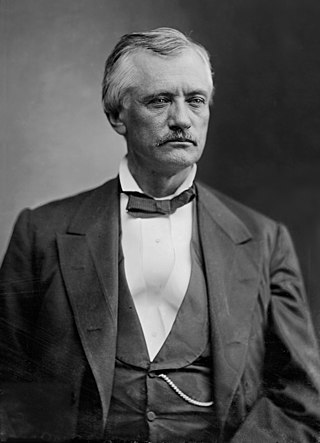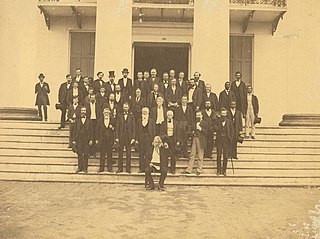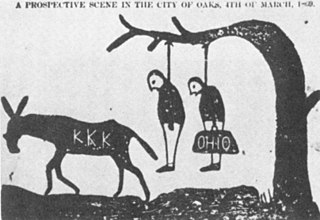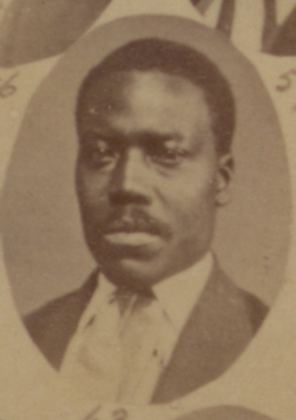
John Tyler Morgan was an American politician was served as a brigadier general in the Confederate States Army during the American Civil War and later was elected for six terms as the U.S. Senator (1877–1907) from the state of Alabama. A prominent slaveholder before the Civil War, he became the second Grand Dragon of the Ku Klux Klan in Alabama during the Reconstruction era. Morgan and fellow Klan member Edmund W. Pettus became the ringleaders of white supremacy in Alabama and did more than anyone else in the state to overthrow Reconstruction efforts in the wake of the Civil War. When President Ulysses S. Grant dispatched U.S. Attorney General Amos Akerman to prosecute the Klan under the Enforcement Acts, Morgan was arrested and jailed.

James Thomas Rapier was an American politician from Alabama during the Reconstruction Era. He served as a United States representative from Alabama, for one term from 1873 until 1875. Born free in Alabama, he went to school in Canada and earned a law degree in Scotland before being admitted to the bar in Tennessee.
More than 1,500 African American officeholders served during the Reconstruction era (1865–1877) and in the years after Reconstruction before white supremacy, disenfranchisement, and the Democratic Party fully reasserted control in Southern states. Historian Canter Brown Jr. noted that in some states, such as Florida, the highest number of African Americans were elected or appointed to offices after the end of Reconstruction in 1877. The following is a partial list of notable African American officeholders from the end of the Civil War until before 1900. Dates listed are the year that a term states or the range of years served if multiple terms.
Alabama's 7th congressional district is a United States congressional district in Alabama that elects a representative to the United States House of Representatives. The district encompasses Choctaw, Dallas, Greene, Hale, Lowndes, Marengo, Pickens, Perry, Sumter and Wilcox counties, and portions of Clarke, Jefferson, Montgomery and Tuscaloosa counties. The district encompasses portions of the Birmingham, Montgomery and Tuscaloosa/Northport urban areas. The largest city entirely within the district is Selma.

Philip Joseph was an African American Republican politician and journalist in Reconstruction and Jim Crow-era Alabama.

The 1892 Alabama gubernatorial election took place on August 1, 1892, in order to elect the governor of Alabama.
January Maull, also known as Jany and whose surname is sometimes spelled Maul, was a state legislator in Alabama during the Reconstruction era. He served in the Alabama House of Representatives in 1873. He represented Lowndes County.
Lawrence S. Speed was a farmer and state legislator in Alabama during the Reconstruction era. He was one of five African Americans who represented Bullock County in those years. He was also a Union League organizer in Bullock County.
Lawson Steele was a state legislator in Alabama during the Reconstruction era. He represented Montgomery County, Alabama. He was a leader in the A.M.E. Church. In 1870, he had substantial and was one of the wealthier African American legislators.
Lazarus "Laddie" J. Williams, sometimes spelled "Latty", was a registrar in 1866 and served in the Alabama House of Representatives during the Reconstruction era in Alabama. He was also a Montgomery city council member for three terms from 1869 to 1874. He and Jeremiah Haralson were both African Americans who represented Montgomery County, Alabama. Williams pushed for civil rights legislation. He headed a special committee that was able to arrange for a conference of conservatives to proceed peacefully. He served in 1873 along with Noah B. Cloud representing Montgomery.
Noah Bartlett Cloud was an American educator, surgeon, and politician. He served as Alabama's "Superintendent of Public Instruction", the superintendent of public schools after the American Civil War; and served as a state representative for Montgomery County, Alabama, in 1873 in the Alabama House of Representatives. As Alabama School Superintendent he sought to establish a public school system in Alabama for both white and black students. He was labeled a "scalawag" by Southerners.
Rev. Arad Simon Lakin was an American minister, and university president. He was a Methodist minister from New York state, sent to Alabama in order to reestablish the national Methodist Church in the state, and was labeled a "carpetbagger" by Southerners.

D. J. Daniels was a state legislator in Alabama. He served in the Alabama Senate in 1872 representing Russell County, Alabama. He was a member of the Alabama House of Representatives in 1874 until being ousted for not being registered or having taken an oath. Daniels and Prince Gardner received more than 2,600 votes while the candidates who replaced them, W. H. Chamber and A. G. Jones, received less than 2,000.
Bristo W. Reese was a state legislator in Alabama. He served in the Alabama House of Representatives succeeding R. L. Bennett, who died, to represent Hale County, Alabama. He served from 1873 to 1875.

Ryland Randolph was a newspaper publisher, Ku Klux Klan leader, and state legislator who lived in Tuscaloosa, Alabama. He used his newspaper, the Independent Monitor, to lambast Republicans during the Reconstruction era as carpetbaggers, scalawags, and freed blacks, and attacked fellow legislator Shandy Jones and others with a cartoon of them being lynched. Jones retreated from Tuscaloosa in 1869 due to threats against him from Klansmen including Randolph and settled in Mobile. According to the first paragraph of Gladys Ward's 1932 masters thesis at the University of Alabama in Tuscaloosa, no one was truer to the white man's cause than Randolph and he was idolized by many.

Jefferson Cobb Walker was an American minister, laborer, and state legislator in Mississippi.
Perry Matthews was a teacher and state legislator in Alabama. He represented Bullock County, Alabama in the Alabama House of Representatives from 1872 to 1876.
Henry Hunter Craig was an American grocer, barber and politician who represented Montgomery County, Alabama in the Alabama House of Representatives from 1870 to 1872

Alexander H. Curtis was a state legislator in the Alabama House of Representatives and the Alabama Senate during the Reconstruction era.
George W. Barber was a carpenter, farmer and state legislator who served in the South Carolina State Senate during the Reconstruction era from 1868 until 1872.








